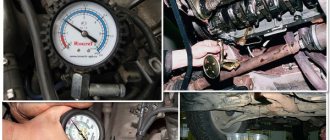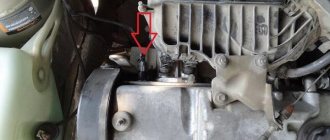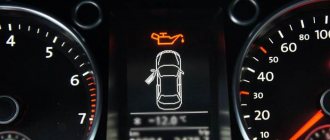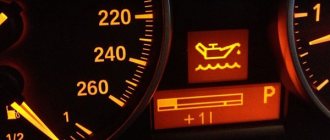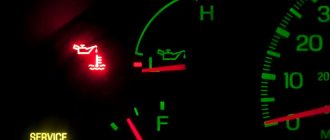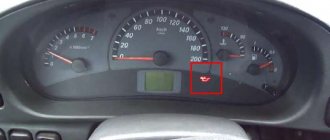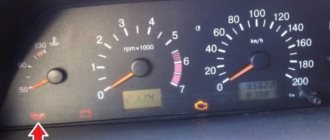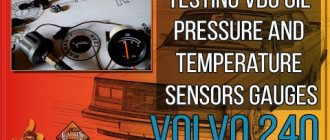Oil light on hot engine
#1 Offline PPG
Twice flame hero
- Forumets
- 2,545 Posts:
- Car: Priora
Priora car 1.6 16 valve. Mileage 88 thousand.
Usually on weekdays I don’t drive during the day: in the morning to work and in the evening from work, if I get stuck in traffic jams, it’s for no more than 5-10 minutes. And last week I had to travel during the day for work. I stood on Malinovsky Street in front of the bridge for a couple of days in a traffic jam in the heat. And after standing for a long time, the oil pressure light began to blink at idle. And the longer it stood, it actually tried to burn continuously.
There's more background here:
a couple of days before, I decided to wash the engine and change the breather tube. I have a Karcher 2, which is weak. In short, I wrapped all the contacts in cellophane and washed the engine without fanaticism. It stood there for an hour while I changed the hoses. And after that the car started to shake. I went to the technician, he counted the errors - he said 2 coils were not working. I unscrewed it and they were wet! He blew them out and said, let’s change the spark plugs in one go. Come on. He unscrews the spark plug from the 4th cylinder, and there is oil in the well! He says the sealant under the cover needs to be changed (the gasket is not installed on the Priora from the factory).
And just during this interval between replacing the spark plugs and replacing the sealant under the engine cover, the oil in my plug began to blink. I immediately went and bought oil (I use liqui molly 5w40), flushing, filters and changed the whole thing (before that I changed the oil in the fall, 7 thousand km ago). The oil light did not come on. But I wasn’t particularly stuck in traffic jams.
Over the weekend I changed the sealant under the cover, the master said that the engine was clean and everything was fine.
Today I went again to work for Dovator and got stuck in a traffic jam in the heat. And the lamp blinked again!
I read the Internet - they write a lot of different things. Now I'm going to my mechanic to measure the oil pressure.
The engine runs smoothly without any extraneous sounds.
I wanted to ask: what could be? Could there be a connection with the engine flush?
Forum member 54 401 Posts:
Car: Golf Variant
Well, that's it, now the remaining half of the forum will stop washing the engine!
Apparently your sensor is failing.
#3 Offline PPG
Twice flame hero
Forum member 2,545 Posts:
Car: Priora
Well, that's it, now the remaining half of the forum will stop washing the engine!
Apparently your sensor is failing.
This is not the first time I have washed it, before everything was fine. True, before when washing I did not remove the plastic casing from the engine, so I did not fill the coils, apparently
I really hope it’s the sensor, but why exactly does this happen on a very hot engine, that’s what interests me?
#4 Offline Stas
Forum member 54 401 Posts:
Car: Golf Variant
In order to determine whether the oil pressure sensor is working or not, you should know its design. It consists of a housing, a transmission mechanism and a measuring membrane. Depending on the pressure with which the oil presses on the membrane, it bends and takes a certain position, simultaneously opening and closing electrical contacts. Based on this principle of operation, we can conclude that to check the functionality of the sensor, you need to take a control pressure gauge and connect it to the circuit instead of the sensor itself. If, when the engine is turned on at idle speed, the pressure gauge produces a pressure of 0.65 kgf per square centimeter or higher, it means that the pressure is within normal limits and it is the oil pressure sensor that is faulty. Of course, sometimes this breakdown occurs on the road, where there is no control pressure gauge at hand. In this case, the functionality of the sensor can be checked in a simpler way.
To do this check, you need to remove the oil sensor and have someone turn the starter (attention: you do not need to start the engine)
If oil flows from the hose to which the sensor is connected, then again the problem is not in the system, but in the sensor. In these simple ways you can quickly check the integrity of your car’s oil system.
Forum member 11,034 Posts:
Checking oil pressure
Checking the oil pressure is carried out to determine its true value on the scale, and to determine the serviceability or failure of the sensor. This requires a pressure gauge with a connected oil-resistant hose, at the end of which there is a threaded fitting whose diameter is equal to the diameter of the sensor thread. The specified sensor is unscrewed and a fitting with a pressure gauge hose is inserted in its place. Then the engine starts.
First, the pressure is measured at idle, then at medium speed, recording the readings of each mode. If the pressure parameters are normal, but the light blinks at idle, you have to blame the sensor. To eliminate doubts, the condition of the contacts in the electrical circuit is checked, and, if necessary, the oil sensor is changed.
Lost oil pressure on Priora
| ignat 93 wrote: |
| I brought the car from the service station (AvtoVAZ). As expected, there was ice in the pan. I support the oil issue, but the point is that the car is still under warranty. They blamed me - I don’t warm it up enough and don’t drive it enough - a candence will form. It seemed to warm up normally. Well, up to 60-70 somewhere. In general, they replaced the filter and oil at my expense! They made me look like an idiot. one of the workers blurted out that I was not the first in these frosts and this is also a sore on the Priors! After the 2nd maintenance, I won’t take the car to them (it’s discolored). I'll change the oil and filter myself - they seem to be crap there!! Smile, for example, on the VAZ 21103 there were never any such problems. |
Looks like this is my case too. Lukoil GENESIS ARMORTECH oil, 5W40, was poured into the Priora in the summer, the mileage on it is about 1.5 thousand. I filled it myself. Recently there were frosts, about -20, without leaving, we warmed up the car (15-20 minutes), turned it off, then didn’t start it for several days. When they started to start it, the oil pressure light began to constantly burn, and the hydraulic valves began to crackle. After removing the oil filter, when cranking with the starter (DPKV was turned off), no oil came out of the pump. When we were looking for the cause of the loss of pressure, we removed the filter and did not notice anything unusual in the oil that spilled onto the filter, the oil was like oil. I installed a new filter, and nothing was pressed through with it (as it didn’t pour out without a filter, it didn’t work) They dragged the car with a tie into a pit, into the garage
We heated the sump with a 2 kW hairdryer to see if the oil would come out when the starter was turned, and removed the filter. Before starting, all the oil that spilled onto the filter from the system was in drops of water. Then we turned the starter, oil came out. We installed the filter, started the engine and after 5-10 minutes, the hydraulics were pumped and stopped rattling.
No oil pressure in the engine(((( — Community “Lada Priora (Lada Priora Club)” on DRIVE2
Hello everyone again... I wrote here about 2 weeks ago about the oil pressure in the Priora... in general, I copied everything that I wrote earlier: Hello everyone. In general, this is the problem, I went through the engine 21126, the pistons on the stk were changed, the block was sharpened, the knee was not when starting off they said the new inserts were normal, the pump and oil receiver were new, Motul 10/40 oil, the head was not repaired except for replacing the caps and grinding in the valves. And after all this, when warmed up to 60 degrees. The oil pump starts flashing, everything is fine when it’s cold... I haven’t measured the pressure yet, but even without it I understand that when it’s hot it disappears. I don’t know what to do. Help. Something like this. Now I will tell you what happened and is happening now.
I went through the engine with a new one, everything was clean and purged, every channel, before assembly and before assembly, the sensor is new, the hydraulic compensators are new... practically a new engine, only with very large holes... now at 60 degrees the oil pan does not start blinking, it just lights up stupidly 60 degrees... The new hydraulic compensators do not pump and do not want to, there is no pressure... We measured it with a mechanical sensor, both cold and hot, under a load of 0.5, but there is a possibility that the sensor is sick... they will bring another sensor soon and we will measure... if so and if I stay, I don’t know what to do but burn everything down *(((((
Level below normal
The minimum oil pressure in the system of a working engine is: 0.7 - 0.8 atm. at idle, and 3 - 4.5 atm. on power. If, when checking, the level turns out to be lower than expected, this may be the cause of a drop in pressure due to “oil starvation”. In this case, you need to find out the reason for the drop in level; there may be several of them.
You need to carefully inspect all joints for oil leaks. Pay special attention to:
- oil filter mounting location;
- pressure sensor;
- oil seal installation locations;
- places where the covers are attached (front and rear), along the perimeter of the valve cover and engine crankcase installations.
Also check the front lower part of the gearbox for leaks; oil leakage in this place indicates a failure of the engine crankshaft rear oil seal. You need to add oil to medium level. If, after starting the engine, the blinking of the light stops, you can drive to the nearest place for diagnostics and, if necessary, repairs.
Instructions for replacing DDM
For safety reasons, replacement work should be carried out with the engine cooled down and wearing cloth gloves. From the tools you should prepare a key for “21”.
The procedure consists of a sequence of steps:
- First, the minus terminal from the battery is disconnected.
- For convenience, remove the air filter.
- The DDM and around it should be wiped with a rag to prevent dirt from getting inside.
- By pressing the wire block, disconnect it from the regulator.
- Using a key, loosen the sensor and unscrew it from the socket.
- We install a new device. In this case, a metal O-ring should also be installed.
- Assembly is performed in the reverse order of removal.
Reason #2
Sometimes smoke appears when climbing a hill, because you have to constantly press the pedal. The driver may not see the smoke, but those driving behind will see everything perfectly. A thin stream of smoke is a sign of malfunctions in the piston system, as well as increased oil consumption.
Most often, malfunctions are associated with wear of the piston rings and grooves on the piston for the rings. Also, the rings can lie down and, as a result, their properties are lost. If the compression rings are not positioned correctly due to carbon deposits, this is also one of the faults that causes blue smoke.
Cylinders can also fail. This leads to a decrease in compression. This problem can only be solved with the help of a major overhaul - sleeve or boring. If the pistons fail, the problem can be solved by purchasing and installing new ones.
Many novice car owners ask experienced ones what to do, the Priora is burning oil. You can try using engine decarbonizers.
With the help of special means, the coke is cleared from the rings, and they can become mobile again. Previously, for this, acetone diluted with oil and kerosene was poured into the cylinders. The mixture was then left for a day and then the oil was changed. If this solution does not help, then you can try a miracle drug from the pharmacy - dimexide. This medicine will clear away any carbon deposits and coke.
The oil pressure light comes on at idle: ways to check
Now let's talk about the case when the low oil pressure warning light comes on while the engine is idling. Below we present available methods for identifying malfunctions, which will generally be useful in diagnosing the condition of the engine lubrication system and engine oil pressure.
- If the oil pressure light comes on, then you should check the engine oil level in the engine and its condition. If the level drops, add oil. A suspicious condition of the oil (black color, excessive thickness) will require thorough flushing of the oil system and subsequent oil change. The smell of gasoline/diesel, an emulsion on the oil filler cap, or severe dilution of the engine oil will indicate problems with the CPG or cracks in the cylinder head/cylinder head. On a working engine, the combustion chambers should be sealed, fuel and antifreeze from the cooling system should not enter the lubrication system.
- The oil pressure lamp may come on at idle immediately after changing the oil during the first start. In this case, the warning light may remain on for 10, 15 or even 20 seconds. If after the specified period of time the low oil pressure lamp does not go out, then you should check the oil filter. The product may be of poor quality, poorly screwed (oil leaks are noticeable in the area where the filter is attached) or defective.
- Check the oil pressure sensor. The oil pressure level at idle speed at around 800 - 900 rpm should not be less than 0.5 kgf/cm2. It is also worth noting that emergency oil pressure sensors on different engines may have different response ranges, which on average range from 0.4 to 0.8 kgf/cm2. This means that if there is a sensor designed to operate at 0.7 kgf/cm2, already during a pressure drop to 0.6 kgf/cm2 the sensor will turn on the emergency oil pressure lamp. This is done for conditional notification of a decrease in pressure in the line of the internal combustion engine lubrication system.
The initial check of the sensor should be done by slightly increasing the crankshaft speed (1000-1100 rpm). In other words, if the oil pressure light goes out when you press the gas, then the following options are possible:
- idle speed is too low (the light blinks at idle);
- low oil pressure in the lubrication system;
- malfunction of the oil pressure sensor;
- engine malfunction;
To accurately measure the oil pressure in the engine, you need to unscrew the sensor and install a pressure gauge in its place. Also, one should not exclude false alarms of the oil pressure sensor at idle speed, which may occur due to contamination of both the device itself and the engine oil channels. In this case, you will need to clean the sensor and clean the lubrication system channels.
As for engine breakdowns that lead to a decrease in oil pressure, indirect signs are increased consumption of fuel and engine oil, the engine emits blue or bluish smoke. In such cases, the oil pressure lamp lights up at idle, taking into account the warmed-up engine. This occurs due to the fact that the heated lubricant liquefies and flows freely through the gaps between various parts (liners, shaft journals, etc.).
As you know, at idle the crankshaft speed is minimal. At the same time, the oil pump also develops a minimum pressure. As a result, a relatively small deviation can lead to the oil pressure lamp coming on at idle, while when the speed rises and the oil pressure in the lubrication system increases, the problem of the low oil pressure warning lamp on the dashboard coming on may not appear.
Engine oil pressure: what it depends on, how to measure it correctly. What is the oil pressure on different engines in idle mode and under load.
Why there may be low oil pressure in the engine, the oil pressure light blinks at idle or under load. Fault diagnosis and repair.
Why does fuel get into the engine oil, what could be the consequences of a malfunction for the internal combustion engine. Gasoline gets into the oil: diagnostics and repair.
Foaming of engine oil in the engine: in what cases and why is this dangerous for the engine. Main causes of malfunction, diagnostics.
Purpose of the diesel engine lubrication system. Components, oil pump performance, cooling function. Malfunctions and prevention.
Causes of oil leaks in the oil filter area: oil flows from under the filter, through the housing, in the area of the fitting, etc. Available diagnostic and repair methods.
The oil can blinks: reasons
Why is the oil pressure light blinking? There may be many reasons, but not so many that they cannot be grasped by consciousness. But a very important point is the sequence in which these reasons will line up in your head! The speed of troubleshooting, and the amount of “weight loss” in your wallet, depends on this.
So the oil pressure light is blinking. First of all, you need to immediately turn off the engine. Raise the hood. Wait about ten minutes, allowing the oil to drain into the engine crankcase. Check the oil level: according to the engine operating instructions, it should be in the middle (but can be a little higher), between the Min marks. and Max. If the oil level is normal, you need to calmly think about the possible reasons for the blinking oil pressure light.
What could be the reasons:
Lubricant quality.
The oil pressure light comes on at idle: ways to check
Now let's talk about the case when the low oil pressure warning light comes on while the engine is idling. Below we present available methods for identifying malfunctions, which will generally be useful in diagnosing the condition of the engine lubrication system and engine oil pressure.
- If the oil pressure light comes on, then you should check the engine oil level in the engine and its condition. If the level drops, add oil. A suspicious condition of the oil (black color, excessive thickness) will require thorough flushing of the oil system and subsequent oil change. The smell of gasoline/diesel, an emulsion on the oil filler cap, or severe dilution of the engine oil will indicate problems with the CPG or cracks in the cylinder head/cylinder head. On a working engine, the combustion chambers should be sealed, fuel and antifreeze from the cooling system should not enter the lubrication system.
- The oil pressure lamp may come on at idle immediately after changing the oil during the first start. In this case, the warning light may remain on for 10, 15 or even 20 seconds. If after the specified period of time the low oil pressure lamp does not go out, then you should check the oil filter. The product may be of poor quality, poorly screwed (oil leaks are noticeable in the area where the filter is attached) or defective.
- Check the oil pressure sensor. The oil pressure level at idle speed at around 800 - 900 rpm should not be less than 0.5 kgf/cm2. It is also worth noting that emergency oil pressure sensors on different engines may have different response ranges, which on average range from 0.4 to 0.8 kgf/cm2. This means that if there is a sensor designed to operate at 0.7 kgf/cm2, already during a pressure drop to 0.6 kgf/cm2 the sensor will turn on the emergency oil pressure lamp. This is done for conditional notification of a decrease in pressure in the line of the internal combustion engine lubrication system.
The initial check of the sensor should be done by slightly increasing the crankshaft speed (1000-1100 rpm). In other words, if the oil pressure light goes out when you press the gas, then the following options are possible:
- idle speed is too low (the light blinks at idle);
- low oil pressure in the lubrication system;
- malfunction of the oil pressure sensor;
- engine malfunction;
To accurately measure the oil pressure in the engine, you need to unscrew the sensor and install a pressure gauge in its place. Also, one should not exclude false alarms of the oil pressure sensor at idle speed, which may occur due to contamination of both the device itself and the engine oil channels. In this case, you will need to clean the sensor and clean the lubrication system channels.
As for engine breakdowns that lead to a decrease in oil pressure, indirect signs are increased consumption of fuel and engine oil, the engine emits blue or bluish smoke. In such cases, the oil pressure lamp lights up at idle, taking into account the warmed-up engine. This occurs due to the fact that the heated lubricant liquefies and flows freely through the gaps between various parts (liners, shaft journals, etc.).
As you know, at idle the crankshaft speed is minimal. At the same time, the oil pump also develops a minimum pressure. As a result, a relatively small deviation can lead to the oil pressure lamp coming on at idle, while when the speed rises and the oil pressure in the lubrication system increases, the problem of the low oil pressure warning lamp on the dashboard coming on may not appear.
Engine oil pressure: what it depends on, how to measure it correctly. What is the oil pressure on different engines in idle mode and under load.
Why there may be low oil pressure in the engine, the oil pressure light blinks at idle or under load. Fault diagnosis and repair.
Why does fuel get into the engine oil, what could be the consequences of a malfunction for the internal combustion engine. Gasoline gets into the oil: diagnostics and repair.
Foaming of engine oil in the engine: in what cases and why is this dangerous for the engine. Main causes of malfunction, diagnostics.
Purpose of the diesel engine lubrication system. Components, oil pump performance, cooling function. Malfunctions and prevention.
Causes of oil leaks in the oil filter area: oil flows from under the filter, through the housing, in the area of the fitting, etc. Available diagnostic and repair methods.
Source
Why the emergency oil pressure lamp is on at idle - significant reasons
Insufficient oil level and incorrect wiring are easily fixable problems. If the icon on the instrument panel is highlighted not due to a malfunction, you should “dig” in the direction of the sensor. Its diagnosis is much more difficult. However, it is not always worth carrying out - it all depends on the circumstances.
Blockage
So, if the oil pressure sensor lights up on a hot engine, you should first perform a simple procedure - clean it. To avoid an embarrassing situation, after unscrewing the touch controller, the mounting hole under it must be plugged with a handy device. An ordinary rag will do just fine for the role of the latter. However, first the control mechanism must be found. By the way, there may even be two of them, as on the VolksWagen T4. Here they are located on the cylinder head and oil filter bracket. Yes, and on the Priora the oil pressure sensor is located on the cylinder head.
Oil consumption rates for Lada Priora
The car can be equipped with one of four engines. Each modification has its own expense. Thus, an 8-valve 1.6-liter engine with a power of 87 horsepower should consume up to 50 grams per thousand kilometers according to standards. The VAZ-21126 model with a power of 98 horsepower should also, according to the manufacturer, have modest appetites. The 1.8 liter model (VAZ-211128) has an oil consumption rate of 300 grams per thousand kilometers.
For 1.6 units, the oil consumption rate does not exceed 50 grams. The latest engine is modernized. Its key features are that with a standard cylinder block, the developers changed the stroke of the pistons by using a different crankshaft and shorter connecting rods. This technical solution led to increased loads on the engine, or more precisely on the pistons, rings, cylinder block walls and connecting rods.
In some cases, if the engine is severely worn out, the Priora consumes up to 3 liters of oil per thousand kilometers. Let's look at the main reasons for increased oil appetite in a car.
Lost oil pressure at idle. — Community “Lada Priora Club” on DRIVE2
Good day everyone, another problem has happened and we can’t solve it in any way. In general, they made the head, changed the guides, then ground in the valves and installed Reserve seals. We reassembled it and the engine began to emit blue smoke, but not always. Sometimes when heating up at idle there was a lot of smoke, it was decided to change the valve seals, we bought Victo Rains seals and immediately left the Prima rings. Since the old ones had gaps and oil leakage on the 2nd and 4th piston. After assembly there was no smoke at all, but when warming up the oil pressure lamp blinked, checked with a mechanical pressure gauge, it showed 0.5 kg at idle at a temperature of 95 degrees. And so it was made. We replaced the oil and filter, the oil receiver and removed the oil pump, measured the pump with a micrometer and it even looked to be in excellent condition. The main liners have not been replaced, but visually they are free of scuffs and scuffs. Next we measured the camshaft journals, the intake one near the oil seal was 23.92 mm and the rest up to 23.95 mm.
In general, I replaced both shafts, since there is nothing left to think about. As a result, the pressure did not improve. The pressure reducing valve holds, but not for very long; when warming up, the compensators begin to knock. That's all we can do... give us some more advice on what and how to check.
Today, purely for the sake of my own curiosity, I bought a set from a VAZ 2106 (pointer, sensor, etc., etc.) installed and connected, as a result, when warmed up at xx, it presses 3 (well, maybe 2.7), at 3000 rpm 4 with kopecks at 5000 about 5 s half
I can’t vouch for the accuracy of the measurements, what I see is what I’m writing, I think everyone has seen the pressure indicator in the wheel.
mileage 5000 km car for half a year oil shell helix hx7 10w-40 I'm going to switch to helix ultra
Or maybe just screw a threesome in there and that’s it? How reliable is this one from 2106? install a standard pressure switch and plug the other end. When should I insert a pressure gauge there? So as not to jerk back and forth.
The standard set is available almost everywhere, I bought it for 120 rubles (banjo, fitting, medical gasket). There was a plug on the banjo for a long time. This set is more convenient because... similar to a constructor - any combination of installation.
Here it is at a more attractive price https://www.aliexpress.com/item/New-Blue-Oil-Pressure-Adaptor-Temperature-Temp-Gauge-Filter-Sandwich-Plate-Sensor-1-8-NPT-Free/ 1052442796.html
Warm up engine oil Zic+10-40 at idle a little more than 1 At, 3000 - about 3 At
Found in the forum archives: The oil pressure in the area of the pressure sensor on the VAZ-21126 engine should be at least 1.2 (kgf/cm2).” Department for analyzing the quality of vehicles in operation. Leading process engineer. Nikolai Nikolaevich Gapchenko
Priora oil pressure blinking
You need to measure the oil pressure. It seems to be low. Stop driving the car until you find out the cause and eliminate it.
Added after 3 minutes By the way, what kind of oil did you fill in, what is the viscosity? Might try changing the oil and oil filter just in case...
Thank you! But the problem is solved, I installed a new sensor, now everything is perfect! By the way, why was it that when I filled in half-blue oil for 900 rubles there was a knock when it was cold, but now I filled in a cheap one for 350 rubles and everything was fine? What a ?
Added after 52 seconds Mileage 140 thousand
Let me share, after washing the engine the oiler blinked at idle and when hot. It even happened a couple of times that the oiler didn’t light up when idling when it was hot, but if I turned it off and started it up, the new sensor solved the problem and it seems that the engine temperature sensor on the dash began to overestimate, because I replaced the one that goes to the ECM, the readings are in Opendiag and on the dash They start to diverge just after 90 degrees, let's see what happens after replacing the sensor.
I won't wash the engine anymore))
Again everyone, Tryam. I'll combine it into one post:
Hello everyone. Such a problem: when the engine warms up to 95 degrees, the oil pressure drops to 0.05-0.06 MPa. 1 - Replaced the oil and filter - did not help 2 - Replaced the oil pump and the main and connecting rod bearings, except for the outer ones. The blood pressure did not rise at all. Please advise something. Added after 19 minutes, I can’t find where to edit the post. Forgot to write: XX revolutions. When cold it is 0.4 MPa and falls smoothly as it warms up. if you raise the speed to 1000, the lamp already goes out, accordingly the pressure is about 0.07-0.08 MPa
Well, I removed the pan 2 times and forgot to look for them (injectors) both times. In general, the principle of their operation, where can I look?
Added after 48 seconds I changed the ring on the oil receiver for the first time, but it was generally clean
Added after 2 minutes just found it from the forum
“In fact, a faulty nozzle (whether jammed or leaky) will only affect the quality of piston cooling.”
Added after 28 seconds and there is no pressure at all, can’t one injector poison like that?
I forgot to write my mileage is 125,500, I’m still leaning towards camshafts, tomorrow an autopsy will show, I hope not the cylinder head. It looks like it ended up on the cylinder head assembly. There are jambs on the shaft journals. And on the beds. On the other hand, failure of camshafts may not be a cause but a consequence of oil starvation. Who thinks what? While we exclude the injectors, it’s hard to believe that they can release 1.5 kg of pressure.
I finally found a jamb nozzle. 1.2 cylinders – 1.4 kgf, 3rd – 0.7, 4th – 1.8. It was blowing with a compressor. I ordered it on Monday through the online store, today they wrote back that it would arrive as early as 06/02. Ppts
Does anyone know where in Novosibirsk you can buy them? Where it was, no one knows what it is and it’s not available. I've been without a car for a month now, and I still need to pack it up.
The epic with the long-awaited – literally, injectors – is over. So far done:
– Immediately change the oil and filter with semi-blue 10w40 Mobil1 – replace the ring on the oil receiver – replace the connecting rod and main bearings nominal – replace the oil pump assembly
Next, disassemble the entire engine, replace the injectors with new ones, and replace the seals, obviously. I myself measured the crankshaft journals with micrometers and found no crime. I took it to the workshop, they seemed to measure it - dimensions in nominal tolerances = new crankshaft.
Replacement of the cylinder head assembly with a new one + new gasket.
I put everything back together again, changed the oil and filter again, I took the oil in a half-blue tin can, whatever it was, I took this Kixx 10w40.
Started it up, waited for the fan to set to 95+ degrees. Pressure 0.9-1 kg
I am dissatisfied with the result; a lot of money and effort combined with nerves.
Added after 1 hour 4 minutes Forgot to write :) I'm waiting for advice.
A couple of weeks ago, exactly the same symptoms appeared (((I checked the oil level. It’s normal. This weekend I plan to start looking for the source of the problem.
First try changing the sensor.
First try changing the sensor.
I'll buy a sensor and change it.
Fur. A pressure gauge would be a better place to start.
Any mechanical pressure gauge or is there a special one for oil? I will buy it tomorrow in Ryazan. Afinogen Polyugaev, I would also be grateful for advice on WHERE it is better to buy

